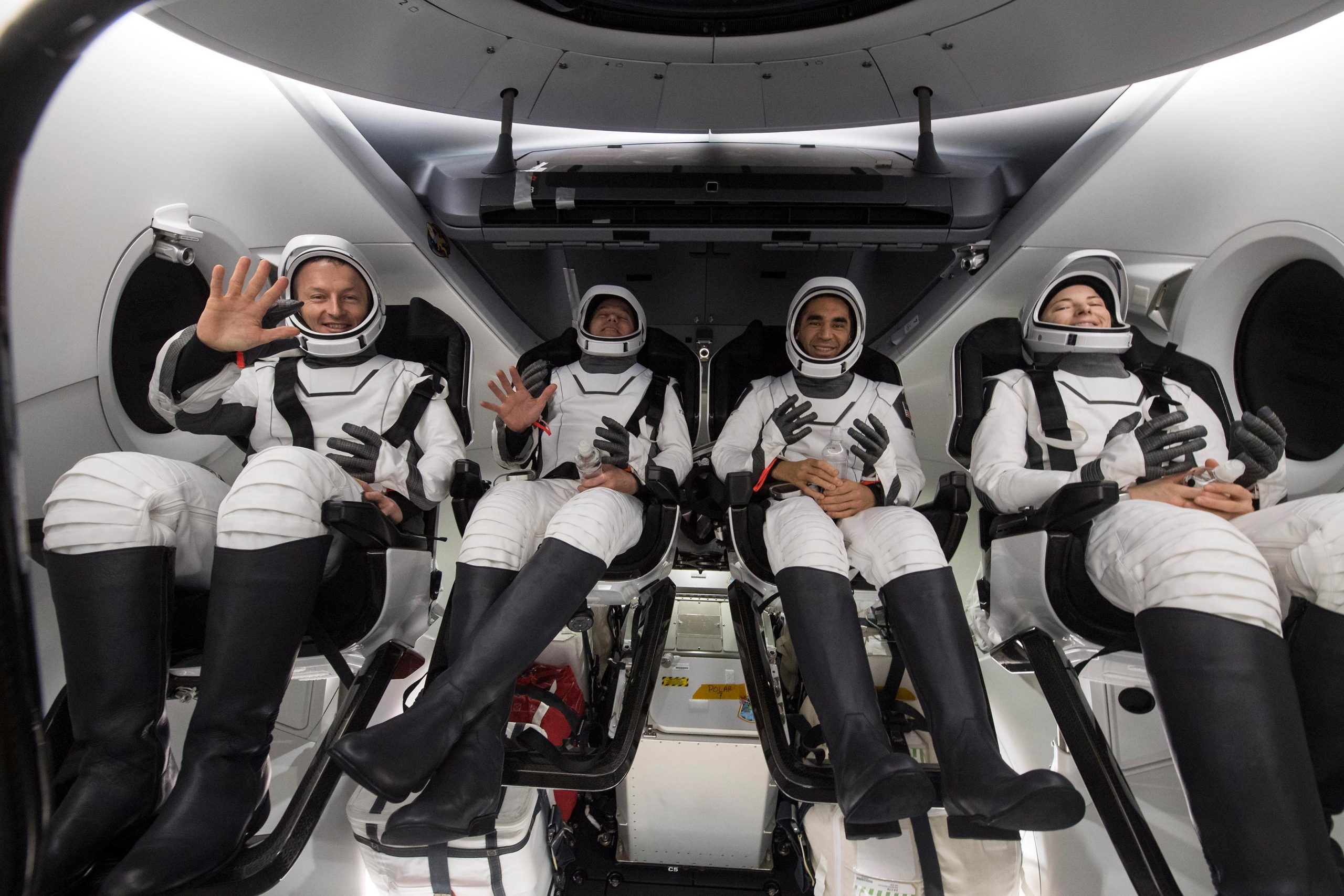

From left to right, ESA (European Space Agency) astronaut Matthais Maurer, NASA astronauts Tom Marshburn, Raja Chari, and Kayla Barron, are seen inside the SpaceX Crew Dragon Endurance spacecraft onboard the SpaceX Shannon recovery ship shortly after having landed in the Gulf of Mexico off the coast of Tampa, Florida, Friday, May 6, 2022. Maurer, Marshburn, Chari, and Barron are returning after 177 days in space as part of Expeditions 66 and 67 aboard the International Space Station. Credit: NASA/Aubrey Gemignani
The Crew-3 astronauts return from the space station …
The spacecraft for another commercial crew mission is on the move ….
And discussing NASA’s budget … a few of the stories to tell you about – This Week at NASA!
The Crew-3 Astronauts Return to Earth
On May 5, the astronauts of NASA’s SpaceX Crew-3 mission closed out their time aboard the International Space Station. NASA astronauts Kayla Barron, Raja Chari, and Tom Marshburn, along with European Space Agency astronaut Matthias Maurer undocked from the station aboard their Crew Dragon “Endurance” spacecraft to begin their return trip to Earth.
They safely splashed down the next day off the coast of Florida to wrap up a nearly six-month mission on the station working with hundreds of experiments and technology demonstrations.

Boeing’s CST-100 Starliner spacecraft rolls out from the company’s Commercial Crew and Cargo Processing Facility at NASA’s Kennedy Space Center in Florida on May 4, 2022, on its way to Space Launch Complex-41 at Cape Canaveral Space Force Station. Credit: NASA/Glenn Benson
Boeing’s CST-100 Starliner Moved to Launch Site
On May 4, teams moved Boeing’s CST-100 Starliner spacecraft from the Commercial Crew and Cargo Processing Facility at our Kennedy Space Center to nearby Space Launch Complex-41 at Cape Canaveral Space Force Station. The move was in preparation for OFT-2, the company’s second uncrewed Orbital Flight Test to the International Space Station. Launch is targeted for May 19 atop a United Launch Alliance Atlas V rocket. The test mission will demonstrate the Starliner system’s human transport capabilities and is expected to be the last uncrewed flight before the Starliner launches American astronauts to the station.
Nelson Testifies During Senate Hearing on NASA’s Budget
NASA Administrator Bill Nelson testified during a May 3 Senate hearing about the president’s Fiscal Year 2023 budget request for the agency. He pointed to commercial partnerships as a key reason the agency is able to achieve its goals, while also getting the most value from the funding granted to it by Congress.
“It’s a new day. Government can’t do it all. You all give us “x amount” of money and we’ve got to make that money happen the way that we’re trying to achieve. And we can leverage that money by working with the commercial industry and through competition, bring those costs down to NASA.”—Sen. Bill Nelson, NASA Administrator

This visualization shows 22 X-ray binaries in our Milky Way galaxy and its nearest neighbor, the Large Magellanic Cloud, that host confirmed stellar-mass black holes. Credit: NASA’s Goddard Space Flight Center
Black Hole Week: Sizing Up Black Holes
One of the coolest offerings we’ve made available this year for Black Hole Week is a visualization featuring details about the best-known black hole systems in our Milky Way galaxy and its neighbor, the Large Magellanic Cloud. The visualization presents 22 X-ray binary systems that host confirmed black holes. They are depicted as seen from Earth with their orbital motions sped up faster than normal. You can check it out, along with lots of other black hole features at nasa.gov/black-holes.

Image of a flood-basalt deposit on Mars in the Marte Vallis region taken by the High Resolution Science Imaging Experiment (HiRISE) instrument on board NASA’s Mars Reconnaissance Orbiter spacecraft. Credit: NASA/University of Arizona/HiRISE
Simulation Suggests Some Volcanoes Warm Climate and Destroy Ozone Layer
A new NASA climate simulation suggests that extremely large volcanic eruptions called “flood basalt eruptions” might significantly warm our climate and devastate the ozone layer that helps protect life on Earth from the Sun’s ultraviolet radiation. This contradicts previous studies indicating that these volcanoes cool the climate. The study also suggests that extensive flood basalt eruptions may have not only helped warm the climates of Mars and Venus too, but could have also doomed the long-term habitability of those planets by contributing to water loss.
That’s what’s up this week @NASA …